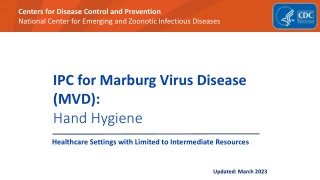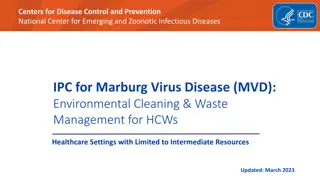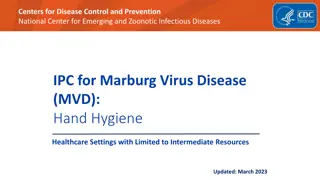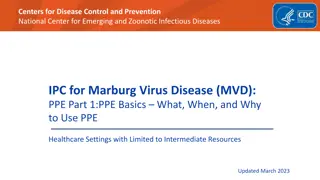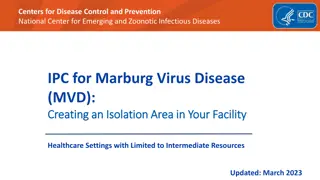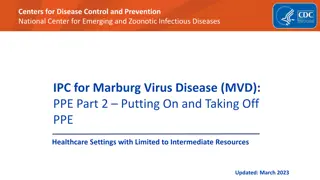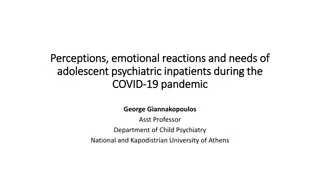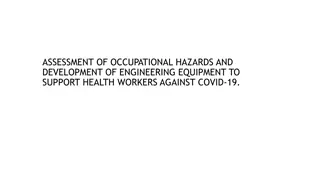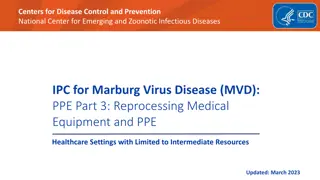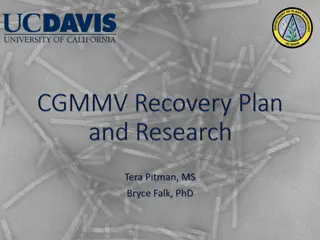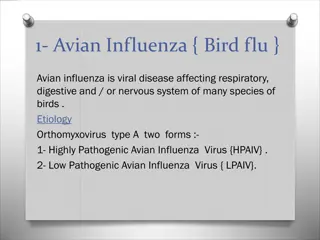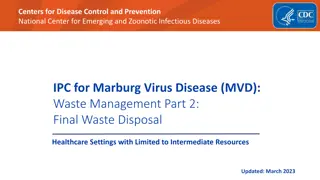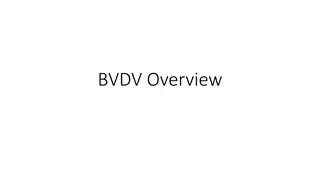Marburg Virus Disease Monitoring Guidelines for Healthcare Workers and Inpatients
Guidelines from the Centers for Disease Control and Prevention on the monitoring of healthcare workers and inpatients for Marburg virus disease. Importance of screening, monitoring procedures, and reasons behind monitoring included.
Download Presentation

Please find below an Image/Link to download the presentation.
The content on the website is provided AS IS for your information and personal use only. It may not be sold, licensed, or shared on other websites without obtaining consent from the author.If you encounter any issues during the download, it is possible that the publisher has removed the file from their server.
You are allowed to download the files provided on this website for personal or commercial use, subject to the condition that they are used lawfully. All files are the property of their respective owners.
The content on the website is provided AS IS for your information and personal use only. It may not be sold, licensed, or shared on other websites without obtaining consent from the author.
E N D
Presentation Transcript
Centers for Disease Control and Prevention National Center for Emerging and Zoonotic Infectious Diseases IPC for Marburg Virus Disease (MVD): Healthcare Worker and Inpatient Monitoring Healthcare Settings with Limited to Intermediate Resources Updated: March 2023
Learning Objectives Learning Objectives After this presentation, participants will be able to Explain why healthcare worker monitoring is important in the context of Marburg virus disease. Explain why inpatient monitoring is important in the context of Marburg virus disease. Describe steps for monitoring inpatients.
Screening for Marburg virus disease involves 2 parts. What are they? ___________ and _____________
Screening for Marburg virus disease involves 2 parts: Temperature check and questionnaire
Why Monitor Healthcare Workers? Why Monitor Healthcare Workers? Healthcare workers are at high risk for exposure to Marburg virus disease. If they are ill, they can infect co-workers or patients. Screening healthcare workers regularly helps quickly identify if they are ill, provide early care, and isolate them from others. This helps protect you, your patients and co-workers, and your community.
Healthcare Worker Monitoring Healthcare Worker Monitoring Screen all healthcare workers prior to each shift. Temperature check Questionnaire: signs and symptoms + risk factors in past 21 days Encourage reporting symptoms don t penalize Sick healthcare workers should be evaluated for possible Marburg virus disease Maintain a record of healthcare workers entering isolation areas because of high-risk for potential exposure
Why Monitor Inpatients? Why Monitor Inpatients? The incubation period for Marburg virus disease is between 2-21 days. Some patients may be admitted for other reasons and may not have signs or symptoms of Marburg virus disease upon admission. They may develop signs and symptoms during their stay in your facility. Quickly identifying them as potentially having Marburg virus disease and isolating them from others helps protect you, your patients and co-workers, and your community.
Inpatient Monitoring Process Inpatient Monitoring Process Apply standard precautions for all patients. Take temperature at least twice a day for all inpatients Assess patients for signs and symptoms at least once a day. Assess immediately in the presence of fever (> 38 C). Complete the Inpatient Monitoring Form.
Inpatient Monitoring Form Inpatient Monitoring Form Temperature - 2 times/day Signs and symptoms 1 time/day Optional: Exposures in the last 21 days This may be asked to increase recall of patient, if feasible
Knowledge Check: Monitoring Knowledge Check: Monitoring You notice that a healthcare worker monitoring patients in the maternity ward of the hospital is walking around to take temperatures of patients and ask about symptoms. They record the temperature but do not record symptoms. When you ask about the patient's symptoms the health worker responds that the patient has felt nauseous, had had some diarrhea and a headache, and has also had a fever since yesterday but that she does not show signs of Marburg virus disease because she is not vomiting and does not look hemorrhagic. 1. What is the risk of not keeping track of symptoms? 2. What is the correct process for in-patient monitoring?
Feedback: Monitoring Feedback: Monitoring 1. What is the risk of not keeping track of symptoms? If symptoms not recorded, can be difficult to track any worsening symptoms Change in nursing staff between shifts means information might not be transferred between shifts 2. What is the correct process for in-patient monitoring? Health workers should complete in-patient identification form COMPLETELY for each patient and not skip over any steps Complete in-patient identification as agreed upon in country or facility policy If a patient meets the case definition for Marburg virus disease, isolate them immediately by separating them from other patients.
Key Takeaways Key Takeaways Monitoring healthcare workers and inpatients helps identify and isolate people who potentially have Marburg virus disease from others in the facility. This helps protect you, your patients and co-workers, and your community. When monitoring inpatients, always fill out inpatient monitoring forms completely and as agreed upon in your facility to ensure that patients who become ill while in your facility can be identified and isolated quickly.
Thank you! For more information, contact CDC 1-800-CDC-INFO (232-4636) TTY: 1-888-232-6348 www.cdc.gov The findings and conclusions in this report are those of the authors and do not necessarily represent the official position of the Centers for Disease Control and Prevention.


